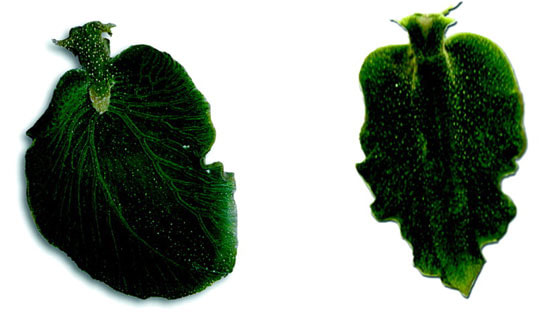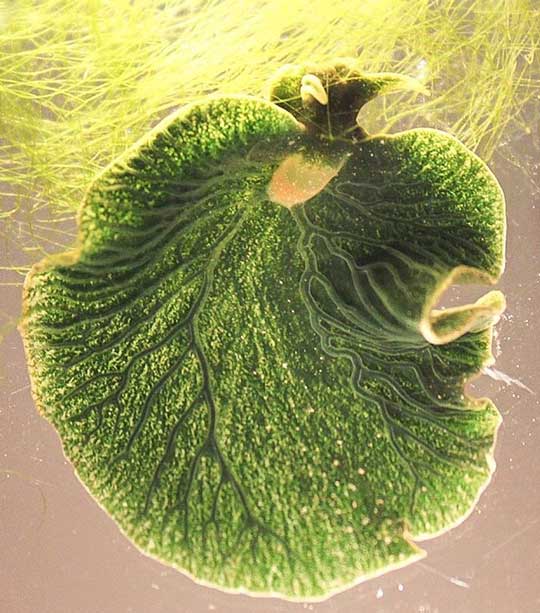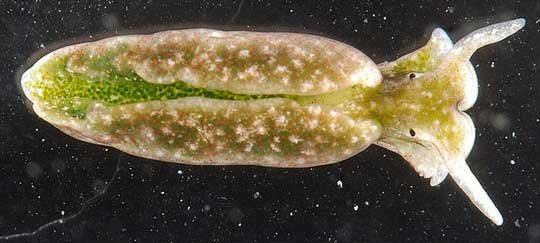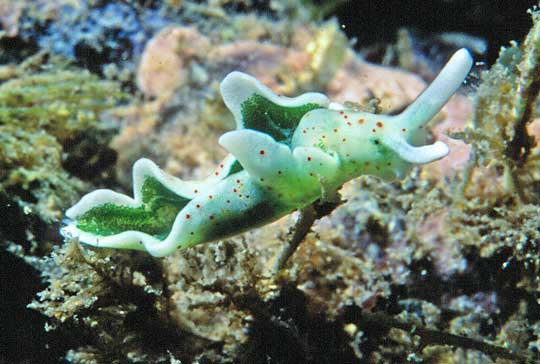|
It's an animal... it's a plant... it's a plantimal! There are some organisms that blur the lines between kingdoms, especially when you look at organisms in the protist, fungi, and bacteria kingdoms. Such blurred lines involving animals are less common, however, and people find them particularly fascinating. (Thanks to Linda Torres, a former student of mine, for suggesting this awesome animal.) I thought it would be fun to take a look at one awesome example, the green sea slug (Elysia chlorotica). This creature has been referred to as a "solar-powered crawling leaf." What the heck is a Green Sea Slug? First of all, I should point out that my opening sentence above is somewhat exaggerated. The green sea slug is obviously an animal, just as all sea slugs are animals. This creature does not tempt us to create a new kingdom called plantimals (although that would be cool!). Green sea slugs, like all slugs, are mollusks (in the phylum Mollusca, along with snails, clams, octopuses, squid, and many others). To narrow it down, green sea slugs are in a group called the sap-sucking sea slugs. They're called sap-sucking because they suck up the cellular contents of photosynthetic algae then use these cellular contents for themselves. Some of them simply digest the cellular contents for food, but others (like the green sea slug) save the living chloroplasts from the algae to use in their own bodies for photosynthesis. This is a rare process known as kleptoplasty (klepto means thief, plasty refers to the stolen chloroplasts). By the way, chloroplasts are the organelles within a plant or algae cell that conduct photosynthesis. Green sea slugs live along the east coast of North America, particularly in shallow salt marshes and tidal pools, where there is plenty of available sunlight. Amazing Facts about Green Sea Slugs If you haven't already guessed, these sea slugs are bright green due to the presence of the stolen chloroplasts, which become distributed throughout the slug's body. Unlike snails, slugs do not have protective shells, so the green color also helps to camouflage these slugs, hiding them from predators. I need to point out an important distinction. A number of different animals (such as corals) keep live algae inside their bodies so that they can benefit from the algae's ongoing photosynthesis. This could be considered a mutualistic relationship between the animal (coral) and the algae, because they both benefit from the convenient arrangement. The green sea slug, on the other hand, breaks down the cells of the algae, and it extracts the algae's chloroplasts and actually uses them within its own cells. Big difference, right? This is not mutualism at all, because the algae obviously does not benefit from being destroyed and eaten. Researchers have found that once a young green sea slug eats its fill of algae for the first time in its life, it never has to eat again, as long as it has access to sunlight. From that point on, the ingested chloroplasts provide it with the food it needs. Just for fun, let's extrapolate this lifestyle to consider what it might be like if humans could do this. In this scenario, after you're born you feed on your mother's breast milk until you're old enough to gobble up a bowl full of live algae. Soon after, your skin turns green. From then on, you never have to eat again, although you would have to stay out in the sunlight a good portion of each day, during which you would have to strip down to your birthday suit because clothing would block the sun and prevent photosynthesis. Okay, that's just downright silly. But wouldn't it be awesome? Wait, there's more to the green sea slug's strange photosynthetic ability. In 2007 scientists discovered that there are genes in green sea slugs that are associated with photosynthesis. These genes are supposedly from the algae eaten by the slugs, but the genes even show up in young slugs that have never eaten algae. Subsequent research revealed even more algae genes in the slugs, some of which are known to play a role in manufacturing chlorophyll. To make a long story short, the research is starting to show that green sea slugs might be capable not only of using the chloroplasts from the algae they eat, they may also be capable of manufacturing their OWN chlorophyll (using the genes they stole from the algae). If so, this makes green sea slugs the only animal known to be capable of making chlorophyll! Here is a video that explain this a bit more. And here's a video showing a green sea slug's movements. Here's a green sea slug with its leaf-like sides rolled up (they do not need to be extended when there is little or no sunlight available). So far I've been writing this as if Elysia chlorotica is the only species of sea slug with these photosynthetic abilities. However, the sap-sucking sea slug group includes several similar species. For example, the species Elysia timida is also known to eat algae and put the ingested chloroplasts to work photosynthesizing in its own body: So, the Green Sea Slug deserves a place in the A.A.H.O.F. (Astonishing Animal Hall of Fame). FUN FACT: The word astonishing, an adjective meaning "causing a feeling of great surprise or wonder," originated in about 1620. As I'm sure you can guess, it is derived from the word astonish, which originated in about 1520 and which literally meant, "to leave someone thunderstruck." Later, the related word astonishment originated in about 1570, with the meaning "paralysis." So, you can see that the early words related to astonishing focused on the dramatic, overwhelming, and possibly even detrimental effects on someone after witnessing or learning something shocking. Later on, astonishing came to be used in a more general sense to describe anything that was unusually remarkable. So, astonishing is another way to say awesome! Photo Credits:
Two green sea slugs on white background - PlantPhysiol.org Green sea slug feeding on algae, with brown background - Karen N. Pelletreau et al., CC BY 4.0 via Wikimedia Commons Green sea slug with sides curled up - Smithsonian Environmental Research Center, CC BY 2.0, via Wikimedia Commons Elysia timidia - Elysia_timida_(Risso,_1818)_.jpg: Parent Géryderivative work: Channer, Public domain, via Wikimedia Commons
0 Comments
Leave a Reply. |
Stan's Cogitations
Everyone needs a creative outlet. That's why I write. Archives
July 2024
|






 RSS Feed
RSS Feed